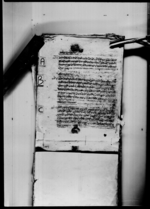A copy of a lālamohara from King Gīrvāṇayuddha ordering that Vaijanātha Josī be provided certain items regularly (VS 1862)
ID: K_0029_0044B
Edited and
translated by Astrid Zotter
Created: 2017-06-02;
Last modified: 2023-02-17
For the metadata of the document, click here
The accompanying edition, translation/synopsis and/or commentary are available under the terms of the Creative Commons Attribution-ShareAlike 4.0 International License
Abstract
This copy of a lālamohara from the king, who according to the date must have been Gīrvāṇayuddha, orders officials involved in the Dasaĩ celebrations at Gorkha to provide certain items to Vaijanātha Josī biannually for him to carry out the Upallokoṭa Dasaĩ rituals properly.Diplomatic edition
[1r]
1९५नंरु12आगेगोर्षाकादसैगर्नजान्याभारादारप्रतीउपल्लोकोटकादसैकाश्रीदेव
3तावैजनाथजोसीकाघरमाराष्याकाछन्तिनकोसद्भावगर्नाकनठूला
4दसैमाचडीआव़र्त९तस्कोदछीणारूपैञा१आनाऽ//वलीकेभेडा१
5भेटीकेअधेली१धोती१पाषी१चैत्राष्टमीमाचंडीआव़र्त१तस्कोदछी
6नाआनाऽ//वलीकेवोका१भेटीअधेली१धोती१प्रतिप्रतिदसैमा
7दीन्यागरसर्वथाईतीसम्वत१८६२सालमितिआसीनवदी१रोजशुभ्म्१
Translation
[1r]
Āge: To those courtiers (bhārādāra) who go to perform the Dasaĩ [rituals] at Gorkhā
The glorious deity [worshipped on occasion] of the Upallokoṭa Dasaĩ [observances] has been placed in the house of Vaijanātha Josī. In order to ensure that his conduct is proper, provide him, under all circumstances, on each of the two Dasaĩs with [the following items]:
On the Great (ṭhūlā) Dasaĩ:
1 rupee, 0 [sukās], 2 ānās3 as the priestly fee (dakṣiṇā) for 9 repetitions of the Caṇḍī, 1 ram for the animal sacrifice, 1 adhelī for bheṭī, 1 dhotī, 1 woolen blanket (pākhī);
on Caitrāṣṭamī:
0 [sukās], 2 ānās as the priestly fee for 1 repetition of the Caṇḍī, one he-goat for the animal sacrifice, 1 adhelī for bheṭī, 1 dhotī.
...day,4 the 1st of the dark fortnight of Āśvina of the [Vikrama] era year 1862 (1805 CE). Auspiciousness.
Commentary
This text, found in an assemblage of lālamoharas (see n. 1), in all likelihood is a copy of an executive order (rukkā) of King Gīrvāṇayuddha. Its text is not only preceded by the abbreviation ru but is also close in its phrasing to an original rukkā (DNA_0010_0019) regulating the annual provision of certain items to another ritual specialist involved in the Dasaĩ rituals at Gorkha.
The document is preceded by a copy (K_0029_0044A) of a related document appointing Vaijanātha Josī as priest for the Upallokoṭa Dasaĩ. The arrangement fixed by these two documents seems to have been a stable one. For more comments and follow-up documents, see Commentary to K_0029_0044A.

